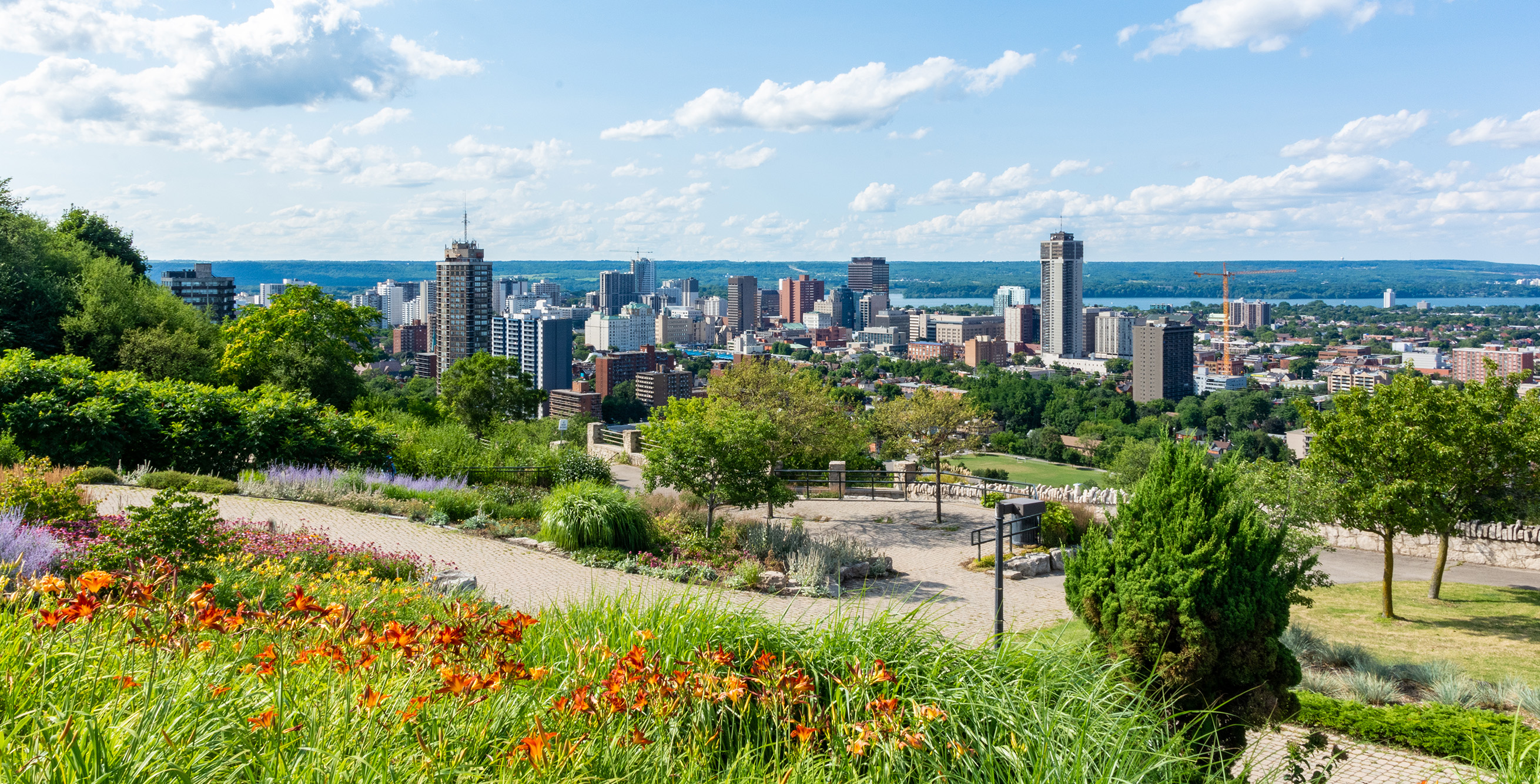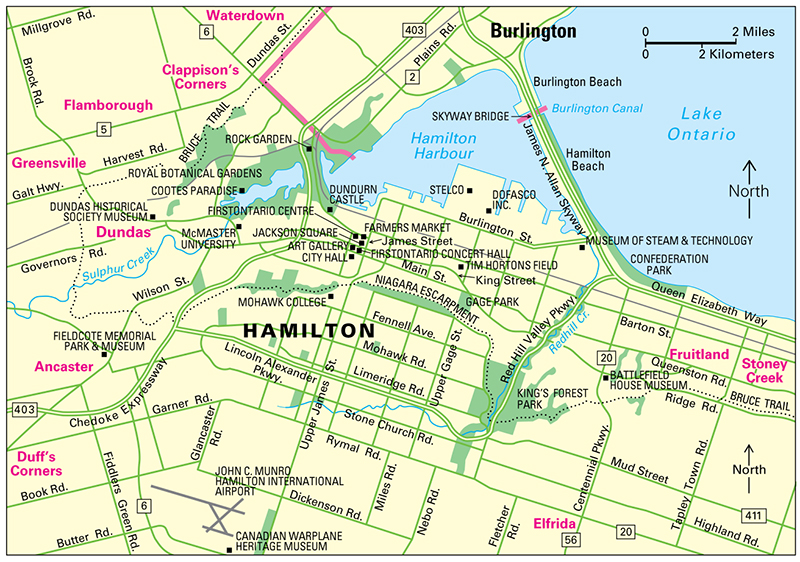Hamilton, Ontario, has long been the center of the Canadian steel industry. Plants in the Hamilton area produce about half the nation’s steel. Hamilton’s location on Hamilton Harbour, also known as Burlington Bay, on the west end of Lake Ontario makes the city an important link in the St. Lawrence Seaway route. Among Canada’s inland ports, only Montreal and Thunder Bay handle more trade than Hamilton. Hamilton ranks as one of Ontario’s largest cities in population.

George Hamilton, a businessman and politician, laid out a town on the site in 1815. The town’s position in the most populated area of Upper Canada (now southern Ontario) helped it grow as a manufacturing and marketing center. Today, Hamilton ranks behind only Toronto and Montreal among Canadian manufacturing cities. But Hamilton’s nearness to Toronto, which lies less than 50 miles (80 kilometers) away, has limited the city’s growth throughout its history. Many businesses have their headquarters in Toronto, with only smaller offices in Hamilton.
The city
of Hamilton covers an area of 432 square miles (1,118 square kilometers), with a population of 569,353. Hamilton’s metropolitan area (a city and its surrounding areas) is the third largest in Ontario. Other communities in the Hamilton metropolitan area include Grimsby and Burlington.

Much of Hamilton lies on a plain between Hamilton Harbour and the Niagara Escarpment, a high ridge that local people call “the Mountain.” Hamilton Harbour is a landlocked triangular harbor. A long sand bar separates the harbor from Lake Ontario. Ships traveling from the lake enter the harbor through a short canal. Motor vehicles cross the canal via the Burlington Bay James N. Allan Skyway.
The intersection of James and King streets is the center of Hamilton’s business district. City Hall stands a few blocks away at Main and Bay streets. A shopping mall and several office buildings occupy Lloyd D. Jackson Square, which lies a few blocks north of City Hall. Nearby is FirstOntario Concert Hall (formerly Hamilton Place), a theater-auditorium complex. The Art Gallery of Hamilton and the Hamilton Convention Centre adjoin the concert hall. Two blocks away is FirstOntario Centre (formerly Copps Coliseum), an arena that seats up to 19,000 people. Tim Hortons Field, home of the Hamilton Tiger-Cats professional football team, lies east of the central business district. It houses the Canadian Football Hall of Fame and Museum.
Hamilton’s steel mills and factories stand along the waterfront. The Royal Botanical Gardens, which include the Cootes Paradise wildlife sanctuary, lie at the west end of the harbor.
People.
About three-fourths of the people in the Hamilton area were born in Canada. Many people in the area have some English, Irish, or Scottish ancestry. The Hamilton area also has many people of French, German, and Italian ancestry.
Economy.
Steelmakers in the Hamilton area produce millions of tons of steel each year. Ships bring iron ore to the area’s steel plants from northern Quebec via the St. Lawrence Seaway.
More than half of the workers of metropolitan Hamilton are employed in service industries. Health care is one of the city’s major economic activities. Other important service industries in Hamilton include education, government, retail trade, and financial services. However, manufacturing continues to be a major driver of Hamilton’s economy. The city makes many steel products, including automotive parts, electrical goods, farm and machine tools, and wire. Hamilton plants also process beef, dairy products, fruits, tobacco, and vegetables from the rich farming region south of the city.
Canadian railroads run through Hamilton and connect with major lines in the United States. Major highways serve the city, and bus lines provide both local and long-distance service. The John C. Munro Hamilton International Airport furnishes service to a number of Canadian and U.S. cities. Toronto Pearson International Airport, just outside Toronto, lies an hour’s drive from Hamilton. Hamilton’s port handles millions of tons of cargo annually.
Hamilton has one daily newspaper, The Hamilton Spectator. The city is served by several radio and television stations.
Education.
The Hamilton-Wentworth public school district has numerous elementary and secondary schools that educate tens of thousands of students. Hamilton also has a Roman Catholic school district that serves many elementary and high school students.
McMaster University, near the Royal Botanical Gardens, owns the only nuclear reactor on a Canadian university campus. In 1971, McMaster opened its Health Sciences Centre, a combination hospital and medical school. Hamilton is also the home of Mohawk College of Applied Arts and Technology.
A public library system, the Hamilton Public Library, serves the city and the surrounding region. The system has a central library and a number of branches.
Cultural life.
The Bach Elgar Choir and the Hamilton Philharmonic Orchestra perform in FirstOntario Concert Hall. Dundurn Castle, in Dundurn Park, was modeled after a Scottish castle. Dundurn Castle was built by the Canadian statesman Sir Allan MacNab. The Art Gallery of Hamilton features drawings, paintings, prints, and sculptures from Canada, France, the United Kingdom, and the United States. Other Hamilton-area museums include the Canadian Football Hall of Fame and Museum, the Canadian Warplane Heritage Museum, and the Hamilton Museum of Steam and Technology.
Hamilton has hundreds of parks. The Royal Botanical Gardens straddle the border between Hamilton and the city of Burlington. Parts of the gardens, including the Rock Garden, have been formally developed. Other sections remain in their natural state. The gardens offer educational programs and tours. Hamilton has been called the City of Waterfalls for the many locations where creeks and streams descend the Niagara Escarpment.
Recreational facilities in Hamilton include playgrounds, recreation centers, golf courses, ice-skating rinks, and tennis courts. The city is home to the Hamilton Tiger-Cats of the Canadian Football League; Forge FC, a soccer team in the Canadian Premier League; and the Hamilton Bulldogs of the junior Ontario Hockey League.
Government.
Hamilton has a council-manager form of government. Voters elect a mayor and 15 councilors to four-year terms. The city gets most of its revenue from local property taxes and from provincial and federal grants.
History.
Indigenous (native) Huron people lived in what is now the Hamilton area before Europeans arrived. French fur traders and explorers charted the region during the 1660’s, but no Europeans settled there until 1778. That year, Richard Beasley and Robert Land, two American colonists who supported the British, moved to the area to escape the American Revolution (1775-1783).
In 1815, George Hamilton bought the land at the head of Lake Ontario and had it surveyed for a town. Hamilton was from a prominent family in the British colony of Upper Canada. The town grew slowly until 1832, when the completion of a ship channel increased trade. Hamilton had 6,832 people when it was incorporated in 1846.
During the construction of the Great Western Railroad, from 1849 through 1855, Hamilton’s population increased from 7,000 to 28,000. This railroad, promoted by Sir Allan MacNab, ran from the Niagara River via Hamilton, along Lake Erie to Windsor and Sarnia, southwest of Hamilton. Hamilton’s first foundry was established during this period to meet the railroad’s need for steel. By 1910, Hamilton mills had joined with others in Ontario and Montreal to form the Steel Company of Canada, Limited (Stelco Inc.), Canada’s largest steel producer. The city’s population grew from 52,000 in 1901 to 82,000 in 1911. Hamilton’s second steel firm, Dominion Foundries and Steel, Limited (Dofasco Inc.), started operations in 1912, when new railroads produced the need for more steel. By 1921, the population of the city had passed 100,000, and by 1951 it was more than 200,000.
During the 1960’s, Hamilton began major air- and water-improvement programs, including construction of a water purification system. City leaders hoped to give Hamilton a new look with the construction of residential and commercial developments in the 1960’s and early 1970’s. But developers had difficulties finding tenants for high-rise apartment and office buildings. Businesses preferred to have their main offices in Toronto, and many families chose to live in houses rather than apartments.
Hamilton entered the 1970’s with a metropolitan area population of almost 500,000. The city’s chief renewal plans for the downtown area centered on Lloyd D. Jackson Square. The first buildings constructed on the square included a 24-story office tower and a banking pavilion. Fifty new stores and an office building opened in the complex in 1977. Another office tower, with 200 additional ground-level stores, was completed in 1984. A hotel opened in 1985. The buildings in Jackson Square are connected to the Convention Centre and FirstOntario Concert Hall by enclosed aboveground walkways.
In 1999, the Ontario legislature passed a law to reform Hamilton’s government. The law enlarged the city to include the urban and rural areas that had been part of the region of Hamilton-Wentworth and the municipalities of Ancaster, Dundas, Flamborough, Glanbrook, and Stoney Creek. The new city boundaries became effective in 2001.
Hamilton’s image as Canada’s “Steel City” began to change in the early decades of the 2000’s. Hamilton experienced a sort of renaissance (rebirth) featuring the development of new residences, retail establishments, and restaurants, as well as a flourishing arts scene. For example, the Supercrawl music and arts festival attracts hundreds of thousands of people annually.
